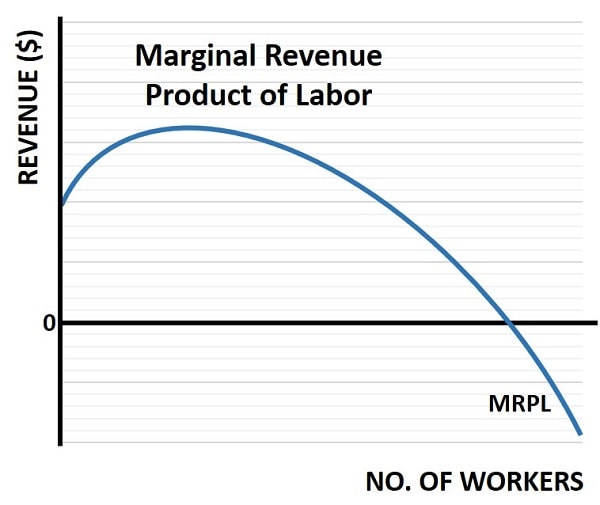- Home
- Economies of Scale
- Marginal Revenue Product

Marginal Revenue Product in Economics Explained (with a Graph)
Marginal Revenue Product quantifies the additional revenue generated from employing one more unit of resource, be it labor or capital, providing critical insights into efficiency and productivity.
Understanding MRP is crucial because it provides a clear picture of the value added by each extra unit, allowing businesses to allocate resources more efficiently. This concept plays a significant role in the broader framework of marginal analysis, which is fundamental in making informed economic decisions.
Marginal revenue itself is the additional income earned from selling one more unit of a good or service. It's essential because it helps businesses determine the point at which they should stop increasing production to avoid diminishing returns. When marginal revenue equals marginal cost, a firm is operating at its most profitable level. This equilibrium is vital for maintaining sustainable growth and ensuring that resources are not wasted.
Marginal
Revenue Product Graph
The Marginal Revenue Product graph above shows that initial recruitment of works yields strong positive growth in marginal revenue for a firm.

The marginal revenue growth then peaks and gradually reduces while still remaining positive. Eventually, marginal revenue turns negative if too many workers are recruited.
How Marginal
Revenue Product is Calculated
Calculating Marginal Revenue Product involves a straightforward but insightful process. The first step is to determine the marginal product of the resource in question, which is the additional output generated by employing one more unit of that resource. For example, if hiring an extra worker leads to the production of five additional units of a product, the marginal product of labor is five. This figure provides a clear indication of the resource's productivity, which is a critical component in the overall calculation of MRP.
Once the marginal product is established, the next step is to multiply it by the marginal revenue, which is the additional income earned from selling those extra units. If each additional unit sells for $10, and the marginal product is five units, the marginal revenue generated from those units would be $50. Therefore, the Marginal Revenue Product of the additional worker would be $50.
This calculation quantifies the value added by the extra resource, allowing businesses to assess whether the cost of employing the additional resource is justified by the revenue it generates.
Marginal
Revenue Product Formula
The formula for Marginal Revenue Product is:
MRP = Marginal Product × Marginal Revenue
Where:
Marginal Product = Additional output from one more unit of input
Marginal Revenue = Additional revenue from selling one more unit of output
Marginal
Revenue Product and Labor and Capital
The relationship between Marginal Revenue Product and labor is particularly significant in understanding how workforce decisions impact profitability. Labor is often one of the most substantial expenses for a business, and its efficient utilization is critical for maintaining a healthy bottom line. MRP provides a framework for evaluating the productivity of additional workers and the revenue they generate.
Businesses must consider the law of diminishing marginal returns, which states that adding more of a variable resource to a fixed resource will eventually yield lower per-unit returns. For example, hiring more workers may initially cause a substantial increase in output and revenue. However, as the number of workers continues to rise, the marginal product of each additional worker will eventually decline. This occurs because the fixed resources, such as machinery or workspace, become increasingly spread thin, reducing the effectiveness of each additional worker.
- In labor-intensive industries such as manufacturing and construction, MRP is often used to determine the optimal number of workers needed to maximize output and revenue. These industries rely heavily on manual labor, and understanding the productivity and revenue contributions of each additional worker is crucial for maintaining efficiency and profitability.
- In capital-intensive industries like technology and automotive manufacturing, MRP is used to evaluate the value added by additional capital investments, such as machinery, equipment, and technology. These industries often require significant upfront investments, and understanding the MRP of capital helps businesses make informed decisions about where to allocate their capital.
FAQs
How does Marginal Revenue Product impact wage determination
in competitive markets?
How does Marginal Revenue Product impact wage determination in competitive markets?
In competitive labor markets, wages tend to align with the MRP of workers. If an employee's MRP is higher, employers are more likely to offer higher wages to attract or retain them. This makes MRP a key factor in setting equilibrium wages.
Can Marginal Revenue Product be negative, and what does that
indicate?
Can Marginal Revenue Product be negative, and what does that indicate?
Yes, MRP can become negative if the marginal product is negative — meaning an additional unit of input reduces total output. This signals overutilization of resources and inefficiencies, often due to excessive labor or poor input coordination.
What is the relationship between Marginal Revenue Product
and marginal cost?
What is the relationship between Marginal Revenue Product and marginal cost?
MRP helps businesses determine whether the revenue from an additional input justifies its marginal cost. When MRP equals marginal cost, the firm is operating efficiently. If MRP is less than marginal cost, the input is not profitable.
How is Marginal Revenue Product used in resource allocation
across departments or projects?
How is Marginal Revenue Product used in resource allocation across departments or projects?
Companies use MRP to compare the productivity and revenue contribution of inputs across different business units or projects. Resources are often reallocated to areas with higher MRP to maximize overall profitability.
How do changes in government policy affect Marginal Revenue
Product?
How do changes in government policy affect Marginal Revenue Product?
Minimum wage laws, labor regulations, and tax incentives can influence MRP indirectly by altering input costs or affecting productivity. For example, a tax credit for capital investment might increase the effective MRP of capital.
What are the limitations of using Marginal Revenue Product
as a decision-making tool?
What are the limitations of using Marginal Revenue Product as a decision-making tool?
MRP assumes accurate measurement of marginal product and marginal revenue, which can be difficult in practice. External factors, non-linear cost structures, and fixed inputs can limit its precision in complex real-world scenarios.
Conclusion
In conclusion, Marginal Revenue Product is a powerful economic tool that can significantly enhance a business's profitability and strategic decision-making.
The dynamic nature of MRP means that businesses must continuously monitor and adjust their strategies to stay competitive in ever-changing market conditions. By staying attuned to factors such as market demand, production efficiency, and resource availability, companies can proactively adapt to economic fluctuations and maintain their competitive edge.
Related Pages:
About the Author
Steve Bain is an economics writer and analyst with a BSc in Economics and experience in regional economic development for UK local government agencies. He explains economic theory and policy through clear, accessible writing informed by both academic training and real-world work.
Read Steve’s full bio
Recent Articles
-
U.S. Industrial Policy & The Unfortunate Sacrifice that Must be Made
Dec 12, 25 03:03 AM
U.S. Industrial Policy now demands a costly tradeoff, forcing America to rebuild its industry while sacrificing bond values, pensions, and the cost of living. -
The Global Currency Reset and the End of Monetary Illusion
Dec 07, 25 03:48 AM
The global currency reset is coming. Learn why debt, inflation, and history’s warnings point to a looming transformation of the world’s financial system. -
Energy Economics and the Slow Unraveling of the Modern West
Dec 06, 25 05:18 AM
Energy economics is reshaping global power as the West faces decline. Explore how energy, geopolitics, and resource realities drive the unfolding crisis. -
Our Awful Managed Economy; is Capitalism Dead in the U.S.?
Dec 05, 25 07:07 AM
An Austrian analysis of America’s managed economy, EB Tucker’s warning, and how decades of intervention have left fragile bubbles poised for a severe reckoning. -
The Looming Global Debt Crisis – According to Matthew Piepenburg
Dec 04, 25 02:38 PM
A deep analysis of the unfolding global debt crisis, rising systemic risks, and the coming reckoning for bonds, stocks, real estate, and the dollar.